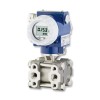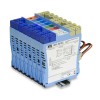Square Root Extraction is a mathematical process which is applied to a linear measurement scale to convert it to a non-linear square root scale.
The square root scale is generated by taking the square root of the ratio between measurement reading and full span.
Over a fixed measurement range with a square root extraction applied, the square root measurement will rise faster than the linear measurement at first, and then steadily slow down as measurement readings approach 100% full scale.
For example the flow of a gas or liquid through a closed pipe is proportional to the square root of the differential pressure. Therefore you can use a differential pressure sensor to measure flow by applying a square root extraction to the linear output.
Related Tools
- Convert linear input to square root extraction output
- Convert square root extraction input to linear output
Glossary of Measurement Signal technical terms
- 2 Wire
- 3 Wire
- 4 to 20 mA Current Loop Output Signal
- 4 Wire
- Amplified Voltage Output
- BFSG – Bonded Foil Strain Gauge
- Deadband
- FSO – Full Scale Output
- HART®
- mV/V – Millivolts per Volt Output Signal
- NC – Normally Closed
- NO – Normally Open
- Piezoresistive Strain Gauges
- Ratiometric
- Span
- Span Offset
- Span Sensitivity
- Threshold
- Totalizer
- Transducer
- Transmitter
- TSL – Terminal Straight Line
- TSS – Thermal Span or Sensitivity Shift
- Turndown Ratio
- USB
- Vented Cable
- Wheatstone Bridge Strain Gauge
- Zero Offset
- Zero Tare
Help from Measurement Signal resources
- Supply voltage and load resistance considerations for pressure transmitters
- What can cause random variation in pressure transducer output
- What is the difference between zero offset and zero drift?
- Why use 4-20mA and 3-15 psi rather than 0-20mA & 0-15psi




